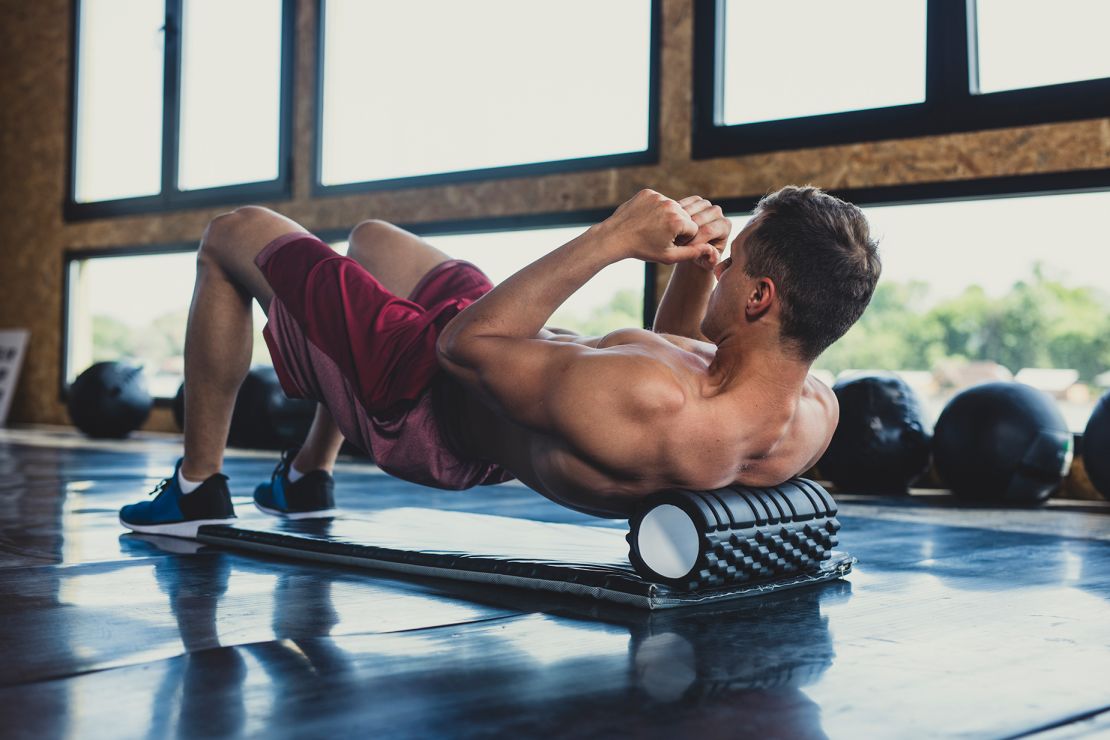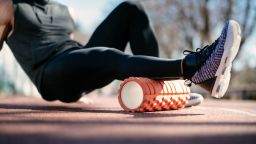Editor’s note: Dana Santas, known as the “Mobility Maker,” is a certified strength and conditioning specialist and mind-body coach in professional sports, and is the author of the book “Practical Solutions for Back Pain Relief.”
Have your legs ever been so stiff and tired that simply bending down to tie your shoes felt like a Herculean task? Whether muscular discomfort comes from an intense workout or too much sitting, wanting to soothe sore muscles is a shared human experience. But because it’s an unrealistic luxury for most of us to receive daily massages or splurge on the latest high-tech massage gun, we need a more practical option.
Enter the foam roller: an affordable and accessible self-care solution that’s backed by science for its muscle-soothing benefits. With consistent use, this simple tool can be a game changer in how you feel and move.
What is a foam roller?
A foam roller, as its name implies, is a cylindrical piece of dense foam. Rollers come in a variety of sizes ranging from 1-4 feet (0.3-1.2 meters) in length and 5-10 inches (13-25 centimeters) in diameter.
The handy cylinders also vary in degrees of firmness, surface textures and features designed to meet desired intensity levels and uses.
The ubiquitous gym staple is available from most major department stores starting at prices as low as $5. Larger sizes and more features (like bumps or points) drive up the price but generally aren’t necessary to reap the science-backed benefits.
What does foam rolling do?
Considered a self-myofascial release tool, a foam roller can relieve soreness and inflammation, increase range of motion, alleviate muscular tension and release tight fascia — the thin layer of connective tissue under the skin surrounding muscles.
Research is increasingly shedding more light on the effectiveness of foam rolling to improve how you feel and move. A comprehensive analysis of 49 studies found that engaging in foam-rolling sessions of 90 seconds to two minutes had the capacity to reduce muscle stiffness and increase range of motion. One longer-term study revealed that foam rolling focused on the backs of the legs three times per week for four weeks improved hamstring flexibility.
And a smaller-scale study found foam rolling during exercise warm-up sessions to be more effective than both static and dynamic stretching for improving flexibility without hampering strength. While more research is warranted, current science on foam rolling shows promising benefits.
Muscle soreness: Considerations and safety tips
While foam rolling offers numerous benefits, it’s important to proceed with caution. Individuals who are pregnant or with conditions such as muscle tears, arthritis, osteoporosis, varicose veins, or any other existing injuries or conditions should seek guidance from their health care provider.
Always practice body awareness when foam rolling to differentiate between general muscle soreness you feel after a workout or prolonged sitting versus cautionary discomfort due to a strain or injury that could be unsafe to roll. If you’re unsure about the source of your muscle soreness or whether foam rolling is safe for you, talk to your physical therapist or doctor.
When selecting a foam roller, keep in mind your pressure tolerance. A harder or bumpier roller will increase sensation. Regardless of the type of roller, always avoid rolling directly over joints, bony areas (such as the neck or spine) or thin skin.

When, where and how to roll:
Incorporating foam rolling into your fitness routine or lifestyle can be simple with some practical guidance.
Include foam rolling as part of your warm-ups prior to any fitness activities to increase blood flow to your muscles and enhance flexibility. As a strength and mobility coach in professional sports, I recommend that all of my athletes prep for their workouts by foam rolling.
If you have a tendency for chronic tension or experience soreness after intense activity or prolonged sitting, use your foam roller to address the areas of discomfort. Personally, I keep a foam roller in my office and use it on my back, glutes and hamstrings after any long bouts of sitting at my desk.
Below I’ve outlined areas you can safely target with your foam roller. Place the roller on the ground and use your body weight to apply rolling pressure (like flattening a piece of dough with a rolling pin). Choose areas that make the most sense for you based on what you’re feeling and any activities you plan to do right after rolling. Roll each of your targeted areas for at least 90 seconds, starting with gentle pressure and gradually increasing intensity as you feel comfortable. Consistency is key — aim for three or more foam-rolling sessions per week to realize lasting benefits.
Calves
With both hands on the floor behind you for support, rest your calves (back of lower legs) on the roller. Cross your legs at the ankle. Roll from just above your ankle to just below your knee. Repeat on the other side.
Hamstrings
Rest your hamstrings (back of upper legs) on the roller with both hands on the floor behind you for support. Bend one knee to place a foot on the roller. Roll your hamstrings from the fold of your glute (bottom) to just above the back of your knees. Repeat on the other side.
Glutes
Sitting on the roller, bend your leg to bring your foot to the opposite knee. Place a hand on the floor for support. Lean your weight into the bent-knee side and slowly roll the entire glute area (back and outside of your hip). Repeat on the other side.
IT band/outside of leg
From a side forearm plank, rest your lower leg on top of the roller and place your top foot on the floor for support. Roll from the outside of your hip to just above your knee. If the sensation is too intense, shift more weight into your supporting foot. To increase intensity, stack your legs.
Adductors/inside of leg
From a forearm plank position with your core engaged for support, slightly spread your legs and open one hip to align the roller on a slight diagonal along your adductors (inner thigh). Roll along the entire length of your adductors from the groins to just before the knee.
Quadriceps
Take a forearm plank position with your quadriceps (thighs) resting evenly on the roller. Engage core muscles and walk your forearms forward and back for support as you roll from just below your hips to just above your knees.
Back
Again, avoid rolling your cervical spine or neck area, and if you have any history of spinal injury or genetic spinal conditions, consult your doctor.
Upper/midback: Lie on the roller with it positioned across your upper back. Keep both knees bent with your feet down and core engaged for support. Maintain a neutral neck position with your hands placed gently behind your head. Roll slowly from your upper back to the base of your ribcage. To increase intensity, cross your arms in front.
Lower back: From the same position, roll from just above your hips to just below your ribs.
Foam rolling is a simple yet powerful tool for soothing sore muscles, improving range of motion and enhancing recovery. By understanding its benefits, following practical guidance, and prioritizing safety, you can harness its full potential to help you feel and move better.
Sign up for CNN’s Fitness, But Better newsletter series. Our seven-part guide will help you ease into a healthy routine, backed by experts.






